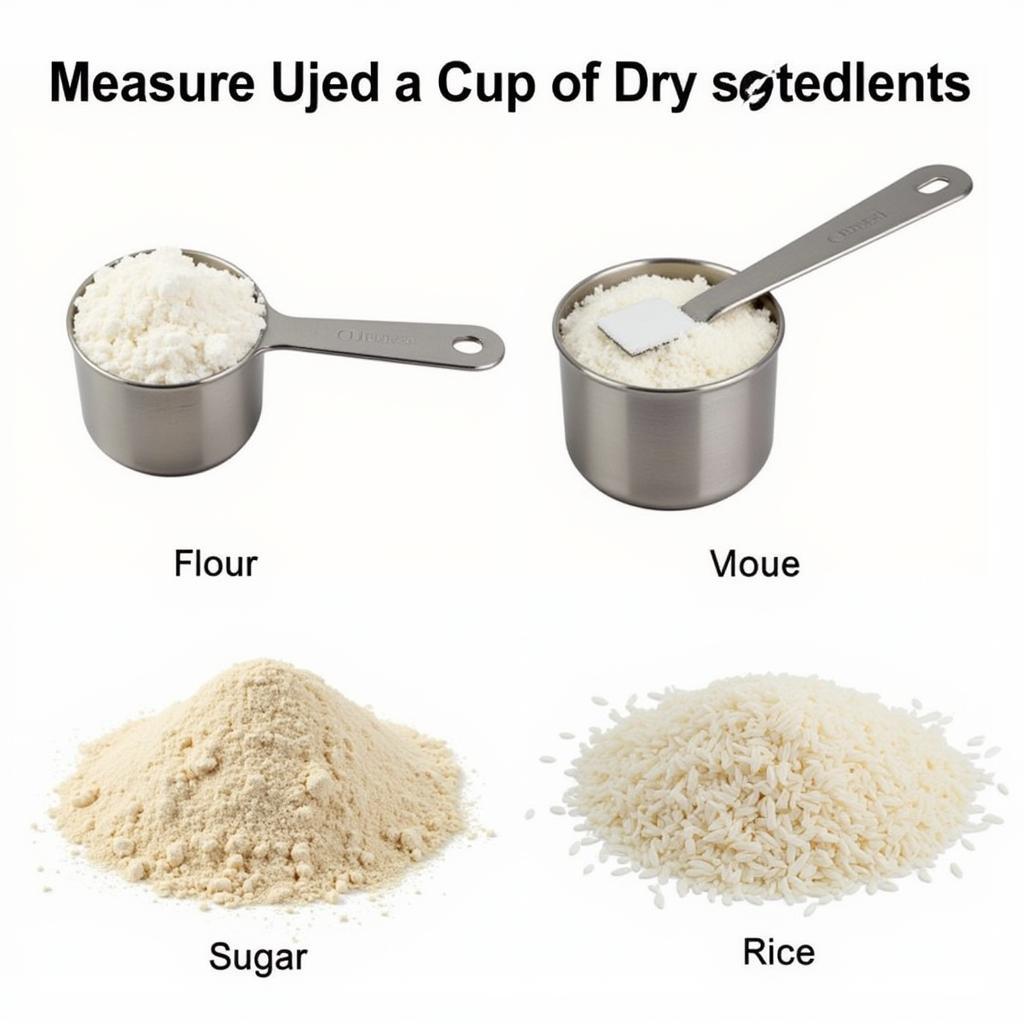A cup is a fundamental unit of measurement in cooking, but how much is a cup, really? Understanding cup measurements is crucial for achieving consistent results in the kitchen. This guide will delve into the nuances of cup measurements, providing clarity and ensuring your culinary creations turn out perfectly every time.
Decoding the Cup: Volume vs. Weight
The term “cup” refers to a volume measurement, typically used for dry and liquid ingredients. It’s important to distinguish between volume and weight. A cup of flour weighs significantly less than a cup of sugar, for example. While a cup is a standard volume, the weight of that cup will vary depending on the ingredient’s density. This difference is why using the correct measuring tools and techniques is essential for accurate recipe execution. Using too much or too little of an ingredient can dramatically alter the final product. For instance, adding too much flour can make baked goods dry and crumbly, while too little can result in a dense, heavy texture.
 Measuring one cup in cooking
Measuring one cup in cooking
How Much is a Cup in Different Systems?
The standard US customary cup is equivalent to 8 fluid ounces or 236.6 milliliters. However, other systems of measurement exist. The metric cup is often 250 milliliters. It’s vital to be aware of which system your recipe uses to avoid inaccuracies. This is particularly important when using recipes from different countries or regions. For example, if you’re using a British recipe that calls for a cup of flour, you should use a slightly larger cup (250ml) than the standard US cup.
Knowing the equivalents of common ingredients can be immensely helpful. You can find numerous conversion charts online or in cookbooks. These resources can be invaluable when adapting recipes or converting between different systems of measurement. For example, you might find yourself needing to convert powdered sugar cup to grams.
Measuring Techniques for Accurate Results
For dry ingredients, use a dry measuring cup and “spoon and sweep” method. Gently spoon the ingredient into the cup without packing it down. Then, level off the excess with a straight edge. This ensures an accurate measurement and avoids compressing the ingredient, which can lead to using more than intended. For liquid ingredients, use a liquid measuring cup placed on a level surface. Pour the liquid into the cup until it reaches the desired marking. Bend down to eye level to ensure accuracy. Using the appropriate measuring tools and techniques is vital for achieving consistent results in the kitchen.
Common Cup Conversions and Equivalents
Knowing common conversions can save you time and effort in the kitchen. For example, knowing that 2 quarts to cups equals 8 cups is handy for scaling recipes up or down. Here are a few common conversions:
- 1 cup = 16 tablespoons
- 1 cup = 8 fluid ounces
- 1/2 cup = 8 tablespoons
- 1/4 cup = 4 tablespoons
- 1 tablespoon = 3 teaspoons
Understanding these conversions can be particularly helpful when working with smaller quantities or when a recipe calls for an unusual measurement.
Why is Accuracy in Cup Measurement Important?
Accurate cup measurement is crucial for achieving the desired texture, consistency, and flavor in your dishes. In baking, precise measurements are particularly important as the chemical reactions involved are highly sensitive to the ratios of ingredients. For example, using too much flour can result in a dry, crumbly cake, while using too little can lead to a dense, gummy texture.
“Precise measurement is the foundation of any successful culinary endeavor,” says renowned pastry chef, Antoine Dubois. “Whether you’re baking a delicate soufflé or preparing a hearty stew, the correct proportions of ingredients are paramount to achieving the desired outcome.” Another expert, culinary instructor Maria Sanchez, adds, “Imagine building a house with incorrect measurements. Cooking is no different. Accuracy in measurements is the cornerstone of a delicious and successful dish.”
Conclusion
Understanding How Much Is A Cup In Cooking is essential for achieving consistent and delicious results in the kitchen. Using the correct measuring tools, techniques, and conversions ensures accuracy and allows you to replicate recipes successfully. So, the next time you’re in the kitchen, remember the importance of accurate cup measurements – they are the key to unlocking your culinary potential. By paying close attention to your measurements and understanding how much is a cup in cooking, you’re setting yourself up for culinary success! And remember, a cup and book can make for a relaxing afternoon, but in the kitchen, precision matters!
FAQ
- What is the difference between a dry and liquid measuring cup?
- How do I measure sticky ingredients like honey or molasses?
- Can I use a regular drinking glass instead of a measuring cup?
- Why do some recipes use weight instead of volume measurements?
- Where can I find a reliable conversion chart for different units of measurement?
- What are some common mistakes people make when measuring ingredients?
- How does the altitude affect baking measurements?
See also our related articles like 11 2 cups of water and 1 cup oil in ml.
If you have any questions, our team at LIVESPORT GFTSC is available 24/7 to assist you. Call us at 0372999996, email us at [email protected], or visit our office at 236 Cầu Giấy, Hà Nội.
